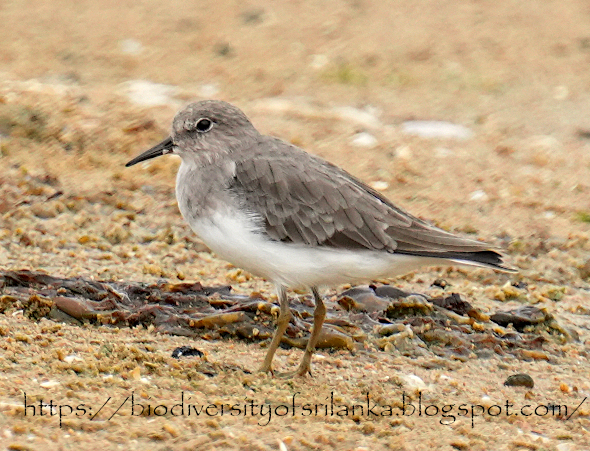An indigenous herb fairly common along roadsides and open country among short grass in the dry zone and in open grassy slopes of the wet lowlands and the hill country. The plant parasite the roots of grasses. Flowering from August to October and December to May.
Pages
- Home
- Flora of Sri Lanka
- Dragonflies & Damselflies of Sri Lanka
- Butterflies of Sri Lanka
- Freshwater Fishes of of Sri Lanka
- Amphibians of Sri Lanka
- Snakes of Sri Lanka
- Tetrapod Reptiles of Sri Lanka
- Mammals of Sri Lanka
- Resident Birds of Sri Lanka
- Migrant Birds of Sri Lanka
- Vagrant Birds of Sri Lanka
- Status Uncertain or Doubtful Birds of Sri Lanka
Tuesday, December 31, 2024
Monday, December 30, 2024
Lesser Whitethroat/අළු හම්බුකුරුල්ලා/හීන් ගෙලසුදු රුසිරැවියා [Alu Hambukurulla/Heen Gelasudu Rusirawiya] (Curruca curruca)
Rather rare winter migrants to the scrub lands, mainly in the coastal areas of dry lowlands. It is a shy bird, often seen hopping, hidden among acacia scrubs as solitary birds or as small flocks.
Sunday, December 29, 2024
හිස කළු මුහුදුළිහිණියා/ගලුතුඩු සයුරුළිහිණියා (Gelochelidon nilotica)
වියලි කලාපීය කලපු, ලේවායන්, වෙරළබඩ විශාල වැව්, වැලි තුඩු සහ ගංගා මෝය ආදියෙහි සුලභ ලෙස හමුවන සංචාරක පක්ෂියෙකි. තෙත් කලාපීය වෙරළබඩ ප්රදේශ වල සහ රට අභ්යන්තරයේ පිහිටි තෙත් බිම් වල දුර්ලභය. ප්රධාන වශයෙන් උත්තර අර්ධ ගෝලයේ රටවලට ශීත සෘතුව බලපවත්වන කාලයේදී මෙරට අවට මුහුදු තීරයට පැමිණෙන මුත් එම රට වලට ගිම්හාන සෘතුව බලපවත්වන කාලයේදීද මෙරට අවට සැරිසරන පක්ෂීන් ඇතැම් විට දැකිය හැක. ලංකාව සහ ඉන්දියාව අතර පිහිටි ආදම්ගේ පාලම ලෙසින් හැඳින්වෙන වැලි පර දූපත් වල අභිජනනය කරන පක්ෂීන්ද ඇතැම්විට සිටින බව විශ්වාස කෙරේ. තනි තනි පක්ෂීන් ලෙසින් හෝ විසිරුණු රංචු ලෙසින් ජල පෘෂ්ඨයට ආසන්නව පියාසර කරමින් වරින් වර ජලය මතු පිට ගිලෙමින්, ජලජ කෘමීන්, ගෙම්බන්, මත්ස්යයන්, කකුළුවන්, ඉස්සන් වැනි සතුන් ගොදුරු කරගන්නා මෙම මුහුදු ලිහිණියා ආහාර සොයමින් නොයන අවස්ථා වලදී බොහෝවිට වෙනත් මුහුදු ලිහිණි විශේෂ සමගින් වැලි පර මත ගිමන් හරින ආකාරය නිරීක්ෂණය කල හැක. සමූහ වශයෙන් අප්රියෙල් සිට ජූනි දක්වා කාලයේ කලපු වෙරල වල හෝ වැලි පර දූපත් වල අභිජනනය කරයි.
English Post >>
Saturday, December 21, 2024
සිඟිති සිලිවටුවා/ටෙමින් හින්නා (Calidris temminckii)
දිවයිනේ පහත රට ප්රදේශ වල තණකොල සහ එවන් මිටි ශාක සහිත නොගැඹුරු දියපාරවල් ඉවුරු වල සහ මඩ වගුරු අද්දර තරමක් දුර්ලභ ලෙස හමුවන සංචාරක පක්ෂියෙකි. නිතර පක්ෂීන් 3 ක් හෝ 4 ක් සහිත රංචු වශයෙන් හමුවන අතර ඇතැම් විට වෙනත් සිලිවටුවන්/හින්නන් සහ පුංචි මාල ඔලෙවියන් හෝ වන සිලිබිල්ලන්/වන සිලිවටුවන් වැනි පක්ෂීන් සමගද හැසිරේ. සිඟිති සිලිවටුවා උතුරු යුරෝපයේ සහ ආසියාවේ අභිජනනය කරයි.
English Post >>Sunday, December 15, 2024
පතන් උකුස්සා/කළු උරිස් පතනකුස්සා (Elanus caeruleus)
පහත රට වියලි කලාපීය සහ කඳුකර විවෘත භූමි, තෘණ භූමි, කුඹුරු සහ පතන් බිම් වල එතරම් සුලභ නොවන ලෙස හමුවන දේශීය පක්ෂියෙකි. පහත රට තෙත් කලාපීය ප්රදේශ වලටද ඇතැම් විට සංක්රමණය වන අවස්ථා වාර්තා වී ඇත. තනි පක්ෂීන් ලෙසින් හෝ ජෝඩු වශයෙන් හමුවන අතර විවෘත බිම් වල පියාඹමින් නිතර එකතැන නැවතී තටු ගසමින් පලගැටියන්, කටුස්සන්, මීයන් සහ කුරුළු පැටවුන් දඩයම් කරයි. දෙසැම්බර් සිට මාර්තු දක්වා කාලයේ සහ ඇතැම්විට නැවතත් ජූලි සිට ඔක්තෝබර් දක්වා මාස වල ගසක මුදුනේ හොඳින් විවෘත ස්ථානයක කෝටු කැබැලි ගොඩ ගසා තනන කපුටු කූඩුවක් වන් වූ කූඩුවක බිත්තර දෙකක් හෝ තුනක් දමා අභිජනනය කරයි.
English Post >>
Monday, December 9, 2024
Ruddy-breasted Crake/රතු මැටි කොරවක්කා/ළය රතු විල් කෙරැළියා [Rathu Meatikorawakka/Laya Rathi Wilkereliya] (Zapornia fusca)
An uncommon breeding resident inhabiting dense vegetation of marshes, paddy fields and other such areas from lowlands to about 1400 m altitude of the hills. Population is also increased during the northern winter months with migrant birds. Ruddy-breasted Crake is a very shy bird and lives as solitary birds or sometime as pairs. It breeds from June to September. The nest composed of reeds and grasses, is placed on the ground under dense cover in marshes or floating in the water. It lays 3 to 6 eggs.
Monday, December 2, 2024
Common Wolf Snake/අළු රදනකයා/ අළු පොළඟා [Alu Radanakaya/Alu Polanga] (Lycodon aulicus)
A very common, non-venomous, terrestrial snake occurs in secondary forests and anthropogenic areas from low country to the hills up to about 1000 m a.s.l. Nocturnal and hides in crevices of loose brickworks, under flower pots, stacks of wood, logs, leaf litter, rubbish heaps and even in houses during the day time. Common Wolf Snake is also known as 'House Snake'' since it frequently enters houses at night (So it is often mistaken for the highly venomous Kraits and killed.) It is also a good climber. When cornered it hides its head underneath the coils of its body (See top left picture) and sometimes vibrates its tail. Common Wolf Snake is an aggressive snake and bites savagely when picked up and handled. It feeds on frogs, geckoes, skinks, rats and other lizards. It lays 5 to 15 eggs.
Subscribe to:
Comments (Atom)






